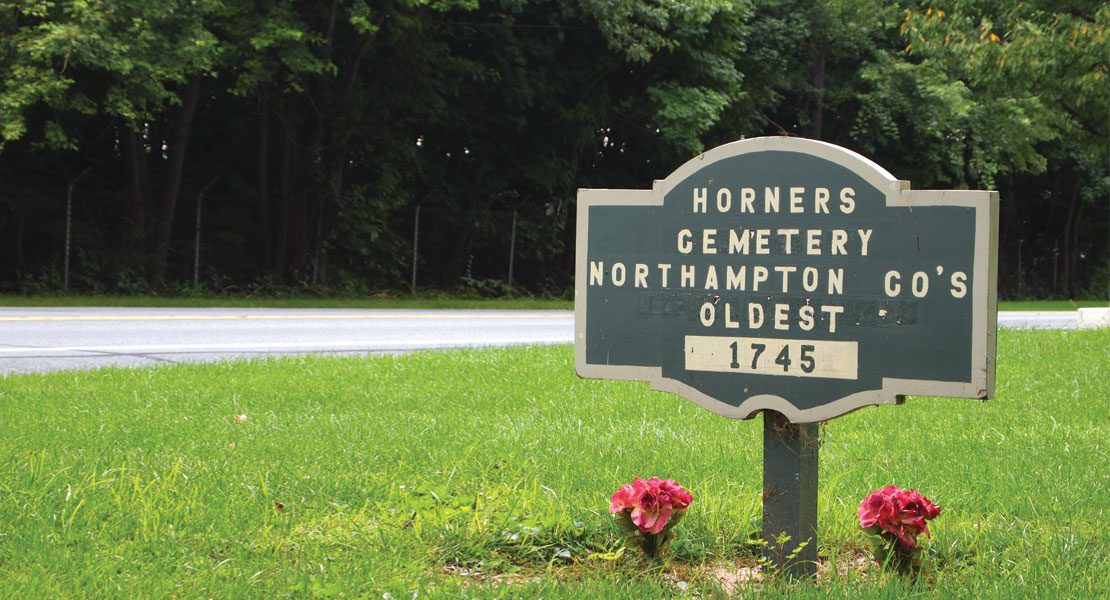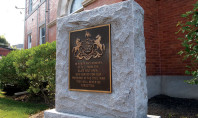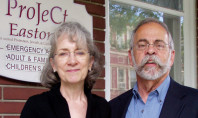Horner’s Cemetery: Where the Past Comes Alive

by Kathryn Finnegan-Clark
In the early 18th century a small band of Presbyterian immigrants, tossed from country to country by religious persecution and famine, settled in Northampton County. They were Ulstermen – “planted” in Scotland by the English king and then banished to Ireland.
The churchyard in which some are buried offers a virtual Who’s Who of the Lehigh Valley’s earliest movers and shakers, many of whom bore the fabled fighting spirit and fierce patriotism of their Scottish and Irish ancestors.
By 1728, some of those pioneer families craved a new frontier and they moved north from Philadelphia to the Lehigh Valley. They called their home Craig’s Settlement, a mere clearing in the wilderness. Northampton’s first permanent settlement, it lies between the towns of Bath and Northampton on Route 329 – one of which were there at the time.
To put their settlement into historical perspective, the City of Easton was not established until 11 years later, Bethlehem two years after that and Nazareth another two. Northampton, still a part of Bucks County, did not become a county until 1752, nearly a quarter of a century later.
Conditions were harsh for the pioneers. A settler’s letter claimed there were few, if any, roads. She said her husband built a shanty when they arrived, “…no chimney and no windows. The light came in where the smoke went out,” she wrote. Benches made of split logs served as chairs. Timbers, reaching from holes in the shanty’s walls to upright posts, formed a bed with mattress made of bags of grass and leaves.
Lured by Penn’s promise of religious freedom and the desire to own their own land, a privilege denied them in Ireland, they settled along the Catasauqua Creek in the wilderness between the Monocacy and Hokendauqua creeks in what is now East Allen Township.
A hardy group, they faced even more troubles here, and their history – and the stories of these settlers who played a part in the birth of America – is written on the tombstones in the small Horner’s Cemetery, Northampton County’s oldest burial place.
The stone-walled cemetery measures only about a quarter acre and is tucked away behind the small God’s Missionary Church, next to a cornfield. It is green and peaceful, surrounded by tall trees, and it is being restored.
Peggy Moser, who is a descendant of one of the cemetery’s occupants, was upset when she discovered the condition of the burial ground in 2008. She is a member of the Daughters of the American Revolution (DAR) and a fellow DAR member had contacted her and asked her to take a photo of an ancestor’s tombstone.
Moser found the stone in what she described as “a jungle,” and, resolving to clean it up, she gathered other descendants of those buried there and eventually founded the Horner’s Cemetery Historical Society. It is governed by a board of seven, four of whom are descendants of the families buried there.
Moser grew up in the stone house built in 1765 that was the home of the Rev. John Rosbrugh, pastor at the church from 1769 to 1777. He also served as a chaplain in the Continental Army and was killed by Hessians at the Battle of Assunpink in Trenton on Jan.2, 1777. He is buried in
the cemetery.
Craig’s Settlement was a substantial one with about 20 houses at one point, according to Moser, who presented a talk at the Sigal Museum in Easton. She said there were 16 founding families who formed Horner’s Church in 1730 and built a log church the following year. The cemetery was established in 1745. Burial records show about 250 interments, said Moser, but only 125 gravestones survive at this point.
Moser and a few volunteers with the help of several people performing court-ordered community service, work at the cemetery every Saturday morning and have recovered a number of broken tombstones tossed into a creek just outside the cemetery wall. Over the years, volunteers have rebuilt the crumbling stone walls.
The cemetery is basically divided into family plots with stones bearing names such as Craig, Horner, Wilson, Palmer, Lattimore, Brown, Ralston, Rosbrugh, Schafer and more.
Perhaps the most poignant grave is that of Jane Kerr Horner, who was murdered Oct. 8, 1763, at the age of 50. A memorial claims she “suffered death by the hand of savage Indians,” the first woman killed by Indians in Northampton County,
The early settlers had lived side-by-side and peacefully with the native Americans until the infamous Walking Purchase of 1737 when the sons of William Penn cheated the Indians. Mrs. Horner was a victim of a vicious attack by hostile natives during the periodic rebellions that followed that event.
Ironically, Mrs. Horner, had two close Indian friends, and local legend has it that their burial places are marked by two small jagged stones just inside the wall.
Buried here is John Ralston, a member of the Constitutional Convention and Continental Congress. He laid out the town of Bath and built Fort Ralston in 1757 to protect settlers from Indian attacks during the French and Indian War. A year earlier hostile Indians had set fire to the settlement. No longer standing, the fort was situated near today’s intersection of Airport Road and Route 329.
Standing in the churchyard’s shade and silence, it’s not difficult to imagine tearful mourners escorting a wooden coffin to a silent grave.
A stone commemorates Gen. Robert Brown, a friend of George Washington and owner of a “friendship tree” Washington gave him. George Palmer, state surveyor-general and county coroner, for whom Palmer Township was named, and state Surgeon-General Dr. Matthew McHenry are both buried here.
Gen. William Lattimore owned the first house in Bath. Hugh Wilson was the founder of Northampton. Both are buried at Horner’s Cemetery.
Moser said the dead include 21 veterans who served in four wars including 15 who fought in the American Revolution. Seven men who bear the title of esquire lie here, and James King, who died in 1745, was the first to have been buried in the little churchyard.
Standing in the churchyard’s shade and silence, it’s not difficult to imagine tearful mourners escorting a wooden coffin to a silent grave.
But the past, almost forgotten, comes alive here – and the dead are remembered.



















